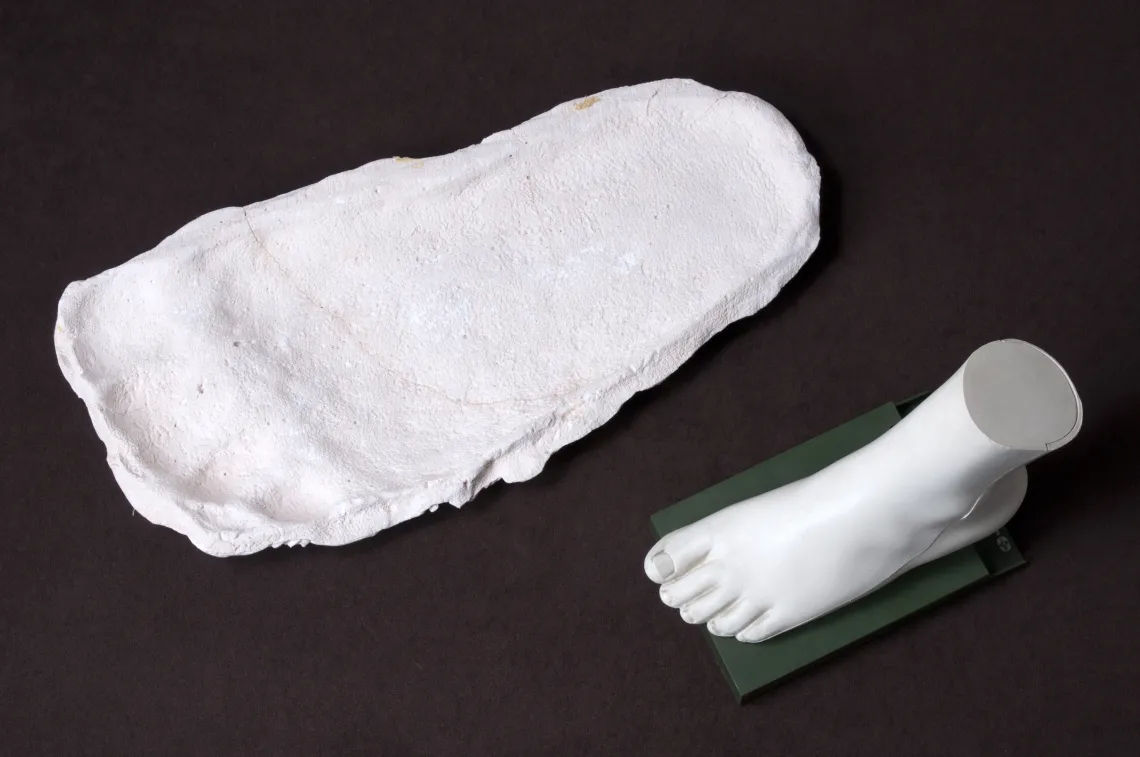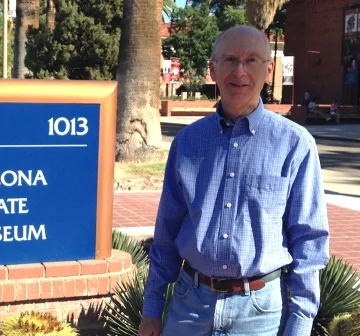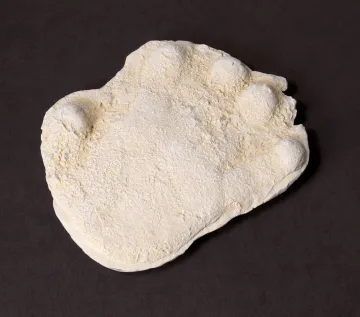
Cast of Alleged Bigfoot Footprint
Footprint found by Roger Patterson, Bluff Creek, northern California, 1967
Length: 18.0 in. (45.7 cm.), Width: 9.2 in. (23.3 cm.),
Plaster cast made by John W. Olsen in 1979 at Arizona State Museum from a cast that was obtained from Grover Krantz
(ASM Catalog No. 2011-470-1a)
This footprint cast is associated with the most celebrated Bigfoot sighting of modern times. In October 1967 Roger Patterson and Bob Gimlin ventured into the woods in search of Bigfoot near where Wallace found his Bigfoot tracks. In Bluff Creek, they sighted a creature strolling through a clearing and they managed to film a short sequence from a reported distance of about 80 feet. The resulting movie is grainy and difficult to interpret, but clearly shows something unlike any animal known to inhabit the region. To some this is incontestable proof that Bigfoot lives among us, but to others it is merely a man or a woman in a gorilla suit.
Links
Printing this page will display URLs for these links.
Cryptozoology: The Centre for Fortean Zoology
References
Bindernagel, John A.
- 2004 The Sasquatch: an unwelcome and premature discovery? Journal of Scientific Exploration 18:53-64.
Byrne, Peter
- 1975 The Search for Bigfoot: Monster, Myth or Man? Acropolis, Washington, D.C.
Ciochon, Russell, John Olsen, and Jamie James
- 1990 Other Origins: The Search for the Giant Ape in Prehistory. Bantam Books, New York.
Cohen, Daniel
- 1970A Modern Look at Monsters. Dodd, Mead & Company, New York.
Daegling, David J.
- 2004 Bigfoot Exposed: An Anthropologist Examines America's Enduring Legend. Altamira Press, Walnut Creek, California.
Dennett, Michael
- 2008 Science and Footprints. Skeptical Inquirer 32:47-51.
Gilmore, David D.
- 2003 Monsters: Evil beings, Mythical Beasts, and All Manner of Imaginary Terrors. University of Pennsylvania Press, Philadelphia.
Heuvelmans, Bernard
- 1995On the Track of Unknown Animals. Translated by R. Garn. Kegan Paul International, London.
Krantz, Grover S.
- 1992 Big Footprints: A Scientific Inquiry into the Reality of Sasquatch. Johnson Books, Boulder, Colorado.
Lozier, J. D., P. Aniello and M. J. Hickerson
- 2009 Predicting the distribution of Sasquatch in western North America: anything goes with ecological niche modelling. Journal of Biogeography 36:1623-1627.
Meldrum, D. Jeffrey
- 2004 Midfoot flexibility, fossil footprints, and Sasquatch steps: new perspectives on the evolution of bipedalism. Journal of Scientific Exploration 18:65-79.
Milinkovitch, Michel C., Adalgisa Caccone and George Amato
- 2004 Molecular phylogenetic analyses indicate extensive morphological convergence between the "Yeti" and primates. Molecular Phylogenetics and Evolution 31:1-3.
Napier, John
- 1973 Bigfoot: The Yeti and Sasquatch in Myth and Reality. E.P. Dutton, New York.
Radford, Benjamin, Michael R. Dennett, Matt Crowley and David J. Daegling
- 2007 The nonsense and non-science of Sasquatch. Skeptical Inquirer 31(3):58-61.
Sanderson, Ivan T.
- 1961 Abominable Snowmen: Legend Come to Life; The Story of Sub-Humans on Five Continents from the Early Ice Age Until Today. Chilton Co., Philadelphia.
Shackley, Myra
- 1983 Still Living? Yeti, Sasquatch and the Neanderthal Enigma. Thames and Hudson, New York.







